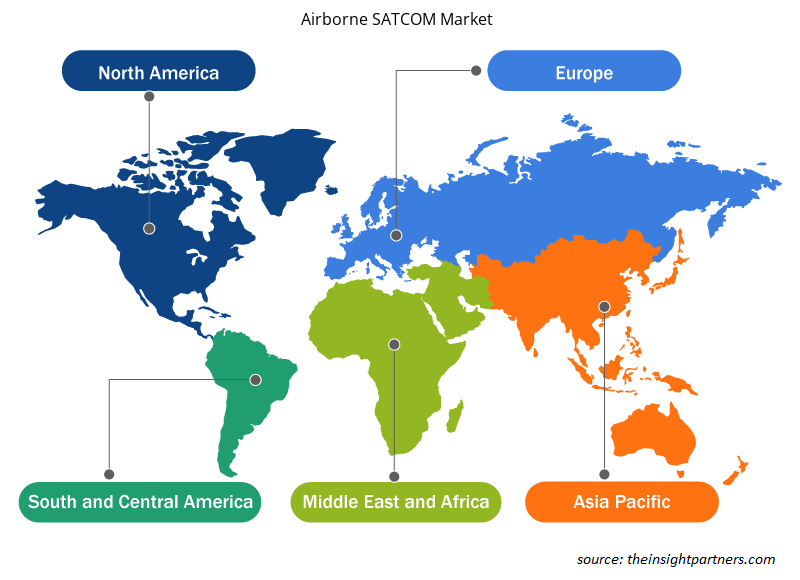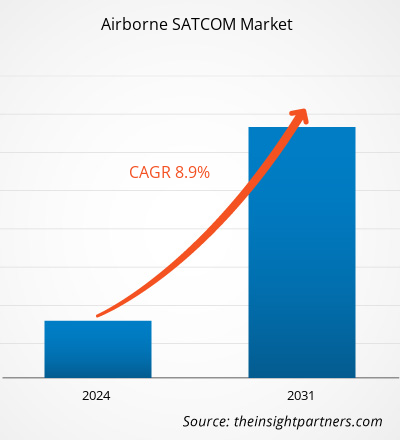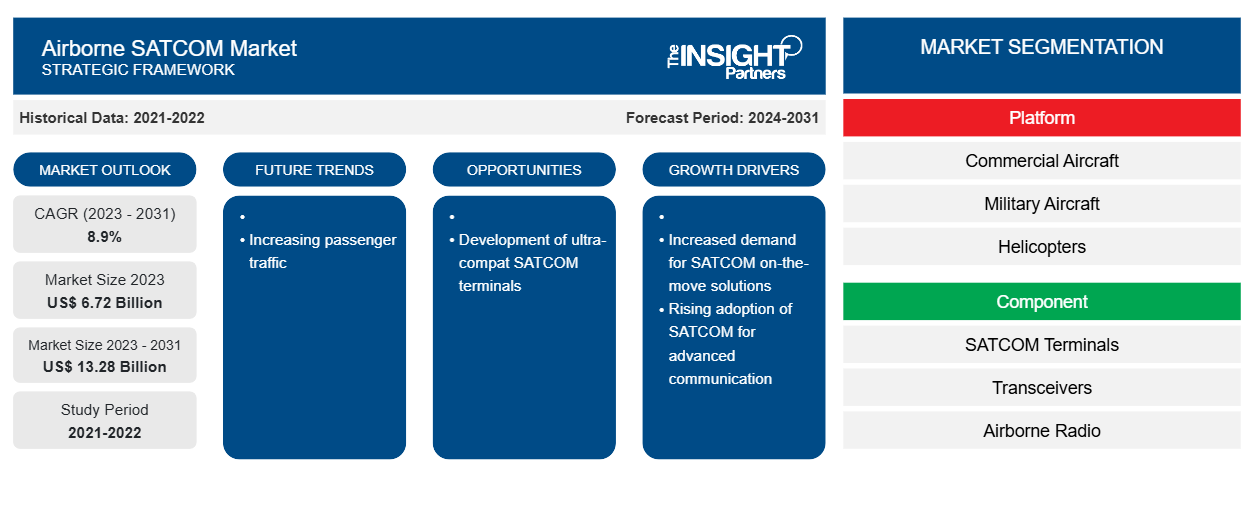Der Markt für luftgestütztes SATCOM wird voraussichtlich von 6,72 Milliarden US-Dollar im Jahr 2023 auf 13,28 Milliarden US-Dollar im Jahr 2031 anwachsen. Der Markt wird zwischen 2023 und 2031 voraussichtlich eine durchschnittliche jährliche Wachstumsrate von 8,9 % verzeichnen. Der zunehmende Fluggastverkehr wird voraussichtlich ein wichtiger Trend auf dem Markt bleiben.
Marktanalyse für luftgestütztes SATCOM
Zu den Akteuren im Bereich luftgestützter SATCOM gehören Collins Aerospace, Honeywell International Inc., General Dynamics Mission Systems, Inc., L3Harris Technologies, Inc., Viasat, Inc., Astronics Corporation und viele mehr. Auf dem Markt für luftgestützte SATCOM sind viele kleine Akteure tätig, die einen erheblichen Anteil des Weltmarkts halten. Die kleinen Akteure sind auch an F&E-Aktivitäten zur Entwicklung neuer Technologien beteiligt, die den Markt in den kommenden Jahren weiter vergrößern werden. Diese Organisationen haben im Laufe der Jahre ihre Investitionen in die Entwicklung neuer und fortschrittlicher luftgestützter SATCOM-Systeme entsprechend den wachsenden Kundenanforderungen mit Hilfe staatlicher Regulierungsbehörden erhöht. Die staatliche Regulierungsbehörde unterstützt die Hersteller luftgestützter SATCOM-Systeme, indem sie Aufträge an Verteidigungs-, Flughafen- und Regierungsbehörden vergibt.
Marktübersicht für luftgestütztes SATCOM
Zu den wichtigsten Interessenvertretern im globalen Ökosystem des Marktes für luftgestütztes SATCOM gehören Rohstoff-/Komponentenlieferanten, Hersteller von luftgestütztem SATCOM, staatliche Regulierungsbehörden und Endnutzer. Die Rohstoff-/Komponentenlieferanten sind die entscheidenden Interessenvertreter im Ökosystem des Marktes für luftgestütztes SATCOM. Zu den wichtigsten Rohstoffen, die in SATCOM verwendet werden, gehören Sender, Empfänger, Transceiver, Antennen, luftgestütztes Funkgerät, Modems und Router, Hochleistungsverstärker , Batterien und andere Geräte. Die rechtzeitige Lieferung all dieser Komponenten ist für einen effizienten Betrieb in den Produktionsanlagen für luftgestütztes SATCOM von entscheidender Bedeutung. Daher wirken sich alle betrieblichen Auswirkungen auf diese Komponentenlieferanten direkt auf den Markt für luftgestütztes SATCOM aus.
Passen Sie diesen Bericht Ihren Anforderungen an
Sie erhalten kostenlos individuelle Anpassungen an jedem Bericht, einschließlich Teilen dieses Berichts oder einer Analyse auf Länderebene, eines Excel-Datenpakets sowie tolle Angebote und Rabatte für Start-ups und Universitäten.
-
Holen Sie sich die wichtigsten Markttrends aus diesem Bericht.Dieses KOSTENLOSE Beispiel umfasst eine Datenanalyse von Markttrends bis hin zu Schätzungen und Prognosen.
Treiber und Chancen auf dem Markt für luftgestütztes SATCOM
Steigende Nachfrage nach SATCOM On-The-Move (OTM)-Lösungen
Eine der wichtigsten Anwendungen der Satellitenkommunikationstechnologie ist die mobile Kommunikation (COTM), die für verschiedene Unternehmen wichtige Dienste bereitstellt. COTM bietet wichtige Anwendungen für Ersthelfer, Katastrophenhilfe, Notfallvorsorge, Fernzugriff und andere Anwendungen für militärische und kommerzielle Endnutzer. Darüber hinaus werden bewegliche Flugzeuge wie kommerzielle, staatliche und unbemannte Luftfahrzeuge (UAVs), die mit einer Satellitenschüssel ausgestattet sind, die in der Lage ist, während der Fahrt eine Kommunikation mit einem Satellitennetzwerk herzustellen und aufrechtzuerhalten, als COTM bezeichnet. Die Nachfrage nach satellitengestützter mobiler Kommunikation (COTM) entwickelte sich als neuer Trend in Verteidigungs- und kommerziellen Luftkommunikationssystemen. COTM-Technologien sind durch die Einführung leistungsstarker L-Band-Satelliten mit Antennenlösungen mit geringer Verstärkung, die ursprünglich für die Sicherheits- und Verteidigungsbranche entwickelt wurden, deutlich effektiver geworden. Im November 2018 kündigte Get SAT die Veröffentlichung der UltraBlade L-Band-Antenne für mobile L-Band-Luftanwendungen an. Kunden und Betreiber, sowohl kommerzielle als auch militärische, wünschen sich höhere Geschwindigkeiten und wettbewerbsfähigere Bandbreitenpreise. Die Netzwerke der Betreiber werden eingeschränkt, da unterschiedliche Plattformen neue Antennentypen oder Möglichkeiten zum Erwerb von Konnektivität erfordern, was zur Entwicklung fortschrittlicher luftgestützter SATCOM-Lösungen für unterwegs führt.
Entwicklung ultrakompakter SATCOM-Terminals
UAVs mit taktischen Langstreckenfähigkeiten werden verwendet, um Echtzeit-Informationen, Überwachungs- und Aufklärungsdaten (ISR) zu erfassen und an Bodenstationen zu übertragen. Zuverlässige, leistungsstarke Satellitenkommunikation gewährleistet eine kontinuierliche Breitbandverbindung bei Aktivitäten außerhalb der Sichtweite (BLOS). In den letzten Jahren hat die Nachfrage nach kleinen Luftfahrzeugen (UAVs) mit leistungsstarken und durchsatzstarken L-Band-SATCOM-Terminals mit geringem Platzbedarf deutlich zugenommen. So gab Intellian im Oktober 2021 bekannt, dass seine neuen L-Band-Terminals FB250 und Fleet One die Inmarsat-Typenzulassung erhalten haben. Das Intellian Fleet One-Terminal ist eine kleine, robuste und kostengünstige Lösung für gleichzeitige Telefon- und Datenkommunikation mit bis zu 150 kbit/s. Darüber hinaus erlaubte Inmarsat, der Marktführer für internationale mobile Satellitenkommunikation, im Januar 2022 Ultra-Intelligence und -Kommunikation, sein neues ultrakompaktes SATCOM-Terminal mit dem Inmarsat Global Xpress-Netzwerk zu nutzen. Das neue Ultraterminal ist in puncto Größe, Gewicht, Leistung und höheren Leistungsstandards Vorreiter, um eine Kommunikationsmöglichkeit im Einsatzgebiet zu schaffen und so die unternehmenskritische Kommunikation zwischen Soldaten im Einsatz und der Kommando- und Kontrollebene zu erleichtern.
Segmentierungsanalyse des Marktberichts für luftgestütztes SATCOM
Wichtige Segmente, die zur Ableitung der Marktanalyse für luftgestütztes SATCOM beigetragen haben, sind Plattform, Komponente und Anwendung.
- Basierend auf der Plattform ist der Markt für luftgestütztes SATCOM in Verkehrsflugzeuge, Militärflugzeuge, Hubschrauber und UAV unterteilt. Das Segment der Verkehrsflugzeuge hatte im Jahr 2023 einen größeren Marktanteil.
- Basierend auf den Komponenten ist der Markt für luftgestütztes SATCOM in SATCOM-Terminals, Transceiver, luftgestütztes Funkgerät, Modems und Router, SATCOM-Radome und andere unterteilt. Das Segment der Transceiver hatte im Jahr 2023 einen größeren Marktanteil.
- Basierend auf der Anwendung ist der Markt für luftgestütztes SATCOM in Verteidigung und Gewerbe unterteilt. Das kommerzielle Segment hatte im Jahr 2023 einen größeren Marktanteil.
Airborne SATCOM Marktanteilsanalyse nach Geografie
Der geografische Umfang des Marktberichts für luftgestütztes SATCOM ist hauptsächlich in fünf Regionen unterteilt: Nordamerika, Europa, Asien-Pazifik, Naher Osten und Afrika sowie Südamerika.
Der asiatisch-pazifische Raum dominierte den Markt im Jahr 2023, gefolgt von den Regionen Nordamerika und Europa. Darüber hinaus wird der asiatisch-pazifische Raum in den kommenden Jahren wahrscheinlich auch die höchste durchschnittliche jährliche Wachstumsrate verzeichnen. China ist eines der größten Länder im asiatisch-pazifischen Raum mit der weltweit größten Bevölkerung und einer der größten Produktionsstandorte der Welt. China verfügt über Standorte von Boeing, Airbus, COMAC, Pratt & Whitney, Changhe Aircraft Industries Corporation, Chongqing Helicopter Investment Corporation, Harbin Aircraft Industry Group, Yuneec International, Shenyang Aircraft Corporation, AVIC Aircraft Corporation und Guizhou Aircraft Industry Corporation. Das Land verzeichnete ein beträchtliches Wachstum bei der Herstellung und Produktion von Flugzeugen, UAVs, Hubschraubern und anderen Flugzeugteilen sowie ein gut etabliertes Zentrum für die Luft- und Raumfahrtproduktion. So gab COMAC beispielsweise bekannt, dass es bis Ende 2021 rund 66 in China hergestellte Flugzeuge im ganzen Land ausgeliefert hat; außerdem gab Airbus China bekannt, dass es im gleichen Zeitraum rund 142 Verkehrsflugzeuge im ganzen Land ausgeliefert hat.
Regionale Einblicke in den Markt für luftgestütztes SATCOM
Die regionalen Trends und Faktoren, die den Airborne SATCOM-Markt während des Prognosezeitraums beeinflussen, wurden von den Analysten von Insight Partners ausführlich erläutert. In diesem Abschnitt werden auch die Marktsegmente und die Geografie von Airborne SATCOM in Nordamerika, Europa, im asiatisch-pazifischen Raum, im Nahen Osten und Afrika sowie in Süd- und Mittelamerika erörtert.

- Erhalten Sie regionalspezifische Daten zum Markt für luftgestütztes SATCOM
Umfang des Marktberichts zu luftgestütztem SATCOM
| Berichtsattribut | Details |
|---|---|
| Marktgröße im Jahr 2023 | 6,72 Milliarden US-Dollar |
| Marktgröße bis 2031 | 13,28 Milliarden US-Dollar |
| Globale CAGR (2023 - 2031) | 8,9 % |
| Historische Daten | 2021-2022 |
| Prognosezeitraum | 2024–2031 |
| Abgedeckte Segmente |
Nach Plattform
|
| Abgedeckte Regionen und Länder |
Nordamerika
|
| Marktführer und wichtige Unternehmensprofile |
|
Marktteilnehmerdichte: Der Einfluss auf die Geschäftsdynamik
Der Markt für Airborne SATCOM wächst rasant, angetrieben durch die steigende Nachfrage der Endnutzer aufgrund von Faktoren wie sich entwickelnden Verbraucherpräferenzen, technologischen Fortschritten und einem größeren Bewusstsein für die Vorteile des Produkts. Mit steigender Nachfrage erweitern Unternehmen ihr Angebot, entwickeln Innovationen, um die Bedürfnisse der Verbraucher zu erfüllen, und nutzen neue Trends, was das Marktwachstum weiter ankurbelt.
Die Marktteilnehmerdichte bezieht sich auf die Verteilung der Firmen oder Unternehmen, die in einem bestimmten Markt oder einer bestimmten Branche tätig sind. Sie gibt an, wie viele Wettbewerber (Marktteilnehmer) in einem bestimmten Marktraum im Verhältnis zu seiner Größe oder seinem gesamten Marktwert präsent sind.
Die wichtigsten auf dem Airborne-SATCOM-Markt tätigen Unternehmen sind:
- ASELSAN A.
- Thales-Gruppe
- Collins Luft- und Raumfahrt
- Cobham Limited
- Honeywell International Inc.
Haftungsausschluss : Die oben aufgeführten Unternehmen sind nicht in einer bestimmten Reihenfolge aufgeführt.

- Überblick über die wichtigsten Akteure auf dem Airborne-SATCOM-Markt
Nachrichten und aktuelle Entwicklungen zum Airborne-SATCOM-Markt
Der Markt für luftgestütztes SATCOM wird durch die Erhebung qualitativer und quantitativer Daten nach Primär- und Sekundärforschung bewertet, die wichtige Unternehmensveröffentlichungen, Verbandsdaten und Datenbanken umfasst. Nachfolgend sind einige der Entwicklungen auf dem Markt für luftgestütztes SATCOM aufgeführt:
- Astronics Corporation (Nasdaq: ATRO), ein führender Anbieter von Spitzentechnologien für die globale Luft- und Raumfahrt, Verteidigung und andere unternehmenskritische Branchen, hat heute das System der Typhon T-400-Serie vorgestellt, das die nächste Generation der Konnektivitätstechnologie für Satellitenkommunikation (SATCOM) darstellt. Die Typhon T-400-Serie ist für den reibungslosen Betrieb in jedem GEO-basierten Ku-Satellitennetzwerk konzipiert und bewältigt effektiv die Herausforderungen, die mit den hohen Kosten für die Ausstattung eines Flugzeugs mit SATCOM-Konnektivität verbunden sind. (Quelle: Astronics Corporation, Pressemitteilung, März 2024)
- Viasat Inc. (NASDAQ: VSAT), ein globales Kommunikationsunternehmen, gab heute bekannt, dass es eine sichere, flexible Breitband-Ku- und Ka-Band-Bordtechnologie in das Airbus C295 MSA-Flugzeug für das Irish Air Corps (IAC) integriert hat, eine Abteilung der irischen Streitkräfte, die sich auf den irischen Luftraum zur militärischen Luftverteidigung konzentriert und Friedenssicherungseinsätze der Vereinten Nationen unterstützt. Viasat und Airbus arbeiteten zusammen, um Viasats flexibles Dualband-Breitbandterminal, das GAT-5530, in das C295 MSA-Flugzeug zu integrieren, um die Leistungsfähigkeit dieser militärischen Mehrzweck-Luftplattform zu verbessern. Airbus hat Anfang dieses Jahres die Auslieferung von zwei C295 MSA-Flugzeugen an die irischen Streitkräfte abgeschlossen. (Quelle: Viasat Inc., Pressemitteilung, Dezember 2023)
Marktbericht zu luftgestütztem SATCOM – Abdeckung und Ergebnisse
Der Bericht „Airborne SATCOM-Marktgröße und -prognose (2021–2031)“ bietet eine detaillierte Analyse des Marktes, die die folgenden Bereiche abdeckt:
- Airborne SATCOM-Marktgröße und -prognose auf globaler, regionaler und Länderebene für alle wichtigen Marktsegmente, die im Rahmen des Berichts abgedeckt sind
- Markttrends und Marktdynamiken für Airborne SATCOM wie Treiber, Einschränkungen und wichtige Chancen
- Detaillierte Porter-Fünf-Kräfte-Analyse
- Marktanalyse für luftgestütztes SATCOM mit wichtigen Markttrends, globalen und regionalen Rahmenbedingungen, wichtigen Akteuren, Vorschriften und aktuellen Marktentwicklungen
- Branchenlandschaft und Wettbewerbsanalyse, einschließlich Marktkonzentration, Heatmap-Analyse, prominenten Akteuren und aktuellen Entwicklungen für den luftgestützten SATCOM-Markt
- Detaillierte Firmenprofile
- Historische Analyse (2 Jahre), Basisjahr, Prognose (7 Jahre) mit CAGR
- PEST- und SWOT-Analyse
- Marktgröße Wert/Volumen – Global, Regional, Land
- Branchen- und Wettbewerbslandschaft
- Excel-Datensatz
Aktuelle Berichte
Erfahrungsberichte
Grund zum Kauf
- Fundierte Entscheidungsfindung
- Marktdynamik verstehen
- Wettbewerbsanalyse
- Kundeneinblicke
- Marktprognosen
- Risikominimierung
- Strategische Planung
- Investitionsbegründung
- Identifizierung neuer Märkte
- Verbesserung von Marketingstrategien
- Steigerung der Betriebseffizienz
- Anpassung an regulatorische Trends























 Kostenlose Probe anfordern für - Markt für luftgestütztes SATCOM
Kostenlose Probe anfordern für - Markt für luftgestütztes SATCOM